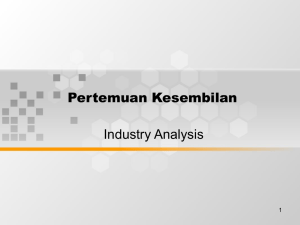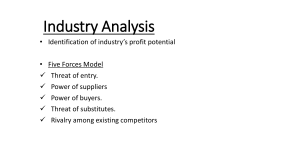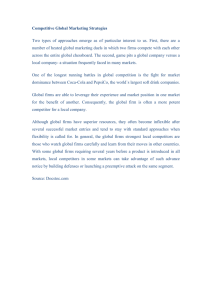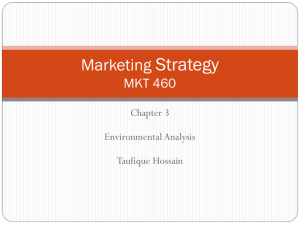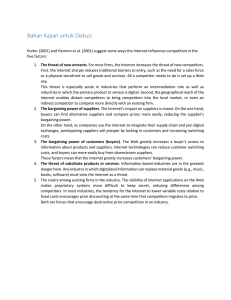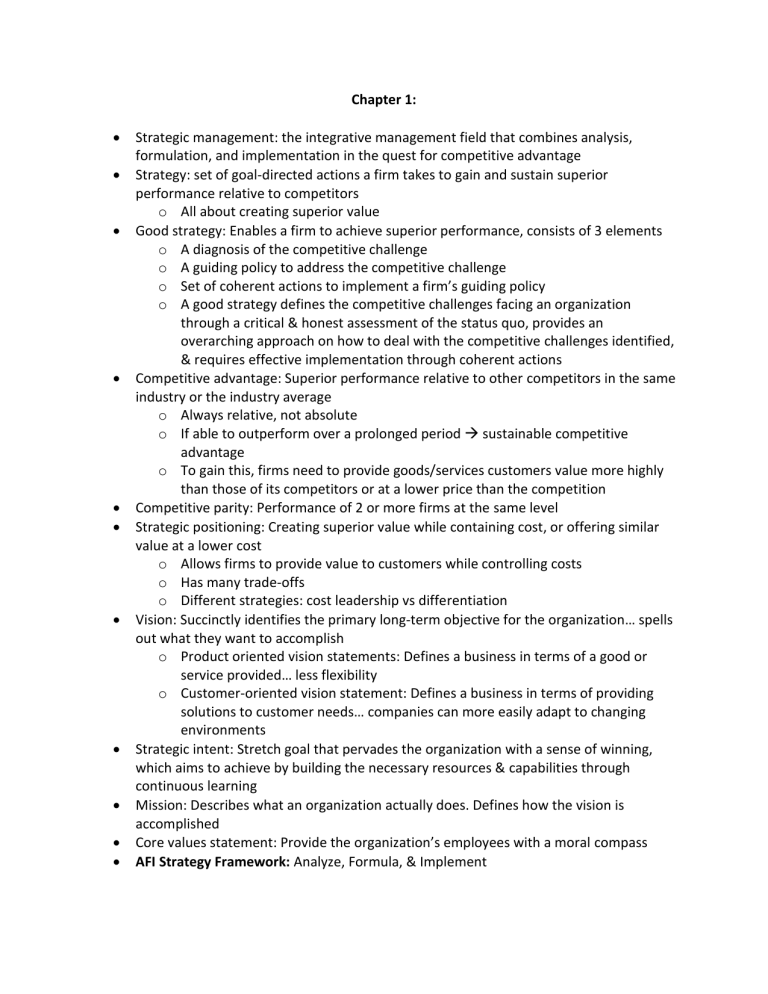
Chapter 1: Strategic management: the integrative management field that combines analysis, formulation, and implementation in the quest for competitive advantage Strategy: set of goal-directed actions a firm takes to gain and sustain superior performance relative to competitors o All about creating superior value Good strategy: Enables a firm to achieve superior performance, consists of 3 elements o A diagnosis of the competitive challenge o A guiding policy to address the competitive challenge o Set of coherent actions to implement a firm’s guiding policy o A good strategy defines the competitive challenges facing an organization through a critical & honest assessment of the status quo, provides an overarching approach on how to deal with the competitive challenges identified, & requires effective implementation through coherent actions Competitive advantage: Superior performance relative to other competitors in the same industry or the industry average o Always relative, not absolute o If able to outperform over a prolonged period sustainable competitive advantage o To gain this, firms need to provide goods/services customers value more highly than those of its competitors or at a lower price than the competition Competitive parity: Performance of 2 or more firms at the same level Strategic positioning: Creating superior value while containing cost, or offering similar value at a lower cost o Allows firms to provide value to customers while controlling costs o Has many trade-offs o Different strategies: cost leadership vs differentiation Vision: Succinctly identifies the primary long-term objective for the organization… spells out what they want to accomplish o Product oriented vision statements: Defines a business in terms of a good or service provided… less flexibility o Customer-oriented vision statement: Defines a business in terms of providing solutions to customer needs… companies can more easily adapt to changing environments Strategic intent: Stretch goal that pervades the organization with a sense of winning, which aims to achieve by building the necessary resources & capabilities through continuous learning Mission: Describes what an organization actually does. Defines how the vision is accomplished Core values statement: Provide the organization’s employees with a moral compass AFI Strategy Framework: Analyze, Formula, & Implement o Framework explains & predicts differences in firm performance, helps managers formulate & implement & strategy that can result in superior performance Chapter 2: Strategic leadership: Executives’ use of power and influence to direct the activities of others when pursuing an organization’s goals o Power: Strategic leader’s ability to influence the behavior of other members to do things they wouldn’t do otherwise o Draw on both formal & informal power Upper-echelons theory: A conceptual framework that views organizational outcomes – strategic choices & performance levels as reflections of the values of the members of the top management team o Favors the idea that effective strategic leadership is the result of both innate abilities & learning o Determine a firm’s ability to gain & sustain competitive advantage through the strategies they pursue Level-5 Leadership pyramid: states effective strategic leaders go through a natural progression of 5 levels where each level builds on the previous Strategy process: Includes strategy formulation & strategy implementation o Formulation: Where & how to compete o Implementation: Strategy execution. How does the work get done? o Corporate strategy: Concerns questions relating to where to compete as to industry, markets, & geography o Business strategy: How to compete? cost leadership, differentiation, or value innovation Occurs within strategic business units (SBUs): Standalone divisions of a larger conglomerate, each with their own profit & loss responsibility o Functional strategy: How to implement a chosen business strategy Top-down strategic planning: rational process through which executives attempt to program future success o Decision-making responsibilities= CEO/upper levels o Analysis formulation implementation o Assumption= we can predict the future from the past; works best in a nonchanging environment Scenario planning: Strategy planning activity in which top management envisions different what-if scenarios to anticipate plausible futures in order to derive strategic responses o Starts with a top-down approach but upper levels think of different scenarios to anticipate plausible futures o Addresses both optimistic & pessimistic futures o More flexible, dynamic, & iterative o In the formulation stage, management develops different strategic plans to address possible future scenarios o In the implementation stage managers execute the dominant strategic plan The strategic option that top managers decide most closely matches the current reality & which is then executed o Circular nature. Interdependence among analysis, formulation, & implementation Black swan events: Incidents that describe highly improbably but high-impact events o E. 9/11 terrorist attacks, Brexit, etc. Illusion of control: Tendency by people to overestimate their ability to control events Realized strategy is a combination of top-down intended strategy & bottom-up emergent strategy o Holistic model of the strategy process that begins with a top-down approach o Executives design an intended strategy, but then have a realized strategy combination of top-down & bottom-up o Emergent strategy: Describes an unplanned strategic initiative bubbling up from deep within the organization o o Strategic initiative: Any activity a firm pursues to explore & develop new products, processes, markets. Can bubble up from deep within a firm through autonomous actions, serendipity, & resource-allocation process Autonomous actions: Strategic initiatives undertaken by lower-level employees on their own volition & often in response to unexpected situations Serendipity: Random events, pleasant surprises, & accidental happenstances that can have a profound impact on a firm’s strategic initiatives Resource-allocation process: The way a firm allocates its resources based on predetermined policies, which can be critical in shaping its realized strategy Chapter 3: PESTEL model: Framework that categorizes & analyzes an important set of external factors (political, economic, sociocultural, technological, ecological, & legal) that might impinge upon a firm. These factors can create both opportunities & threats for the firm o o Political factors: result from the processes & actions of government bodies that can influence the decisions & behavior of firms… ways firm can control/influence: nonmarket strategies such as lobbying, PR, & contributions o Economic factors: Largely macroeconomic, affecting economy as a whole Growth rates, levels of employment, interest rates, price stability (inflation & deflation), currency exchange rates o Sociocultural factors: capture a society’s cultures, norms, & values o Technological factors: capture the application of knowledge to create new processes & products o Ecological factors: Involve broad environmental issues such as the natural environment, global warming, & sustainable economic growth o Legal factors: Include the official outcomes of political processes as manifested in laws, mandates, regulations, & court decisions Industry effects: Firm performance attributed to the structure of the industry in which the firm competes Firm effects: Attribute firm performance to the actions strategic leaders take… strategic leaders’ actions tend to be more important in determining firm performance than the forces exerted on the firm by its external environment Industry analysis: A method to identify an industry’s profit potential and derive implications for a firm’s strategic position within an industry Strategic position: Relates to a firm’s ability to create value for customers while containing the cost to do so… firms that create largest gap (V-C) are those that sustain competitive advantage Five Forces Model: Framework that identifies 5 forces that determine the profit potential of an industry & shape a firm’s competitive strategy o Views competition broadly to encompass other forces in an industry: buyers, suppliers, potential new entry of other firms, & threat of subs o Profit potential of an industry is a function of 5 forces that shape competition: threat of entry, power of suppliers, power of buyers, threat of subs, & rivalry among existing firms o Economic Value= V-C (want to widen this gap) o The stronger the 5 forces, the lower the industry’s profit potential, making the industry less attractive for competitors reverse is true o o The threat of entry: Describes the risk that potential competitors will enter the industry Can reduce industry profitability because incumbent firms may lower prices to make entry less attractive to competitors & it may also cause incumbents to spend more to satisfy existing customers Entry barriers: Obstacles that determine how easily a firm can enter an industry & often significantly predict industry profit potential… advantageous for incumbent firms Economies of scale: cost advantages that accrue to firms with larger output because they can spread fixed costs over more units or employ technology more efficiently Network effects: Describe the positive effect that one user of a product/service has on the value of that product/service for other users. Value of product/service increases w/ the number of users o Threat of entry is reduced when effects= high Customer switching cost: Incurred by moving from one supplier to another Capital requirements: “price of the entry ticket” into a new industry Government policy Credible threat of retaliation o The power of suppliers: Captures pressures that industry suppliers can exert on an industry’s profit potential Can reduce firm’s profitability: powerful suppliers can demand higher prices or reduce quality & they can also capture some of the EV created When is power of suppliers high: supplier’s industry is more concentrated than the industry it sells to, suppliers don’t depend on you heavily for revenue, incumbents face high switching costs, products are differentiated, & there are no substitutes o The power of buyers: Concerns the pressure an industry’s customers can put on the producers’ margins in the industry by demanding a lower price or higher quality product When is power of buyers high: few buyers & each purchase large quantities, products are undifferentiated, low/no switching costs o Threat of subs: Idea that products/services available from outside the given industry will come close to meeting the needs of current customers Threat is high when: Sub offers an attractive price-performance trade-off Buyer switching cost to sub is low Rivalry among existing competitors: Intensity with which companies within the same industry jockey for market share & profitability o Factors that affect: o Competitive industry structure: elements & features common to all industries: number & size of competitors, firm’s degree of pricing power, type of product, height of entry barriers Perfect competition, monopolistic competition, oligopoly, & monopoly o Industry growth Strategic commitments: firm actions that are costly, long-term oriented, & difficult to reverse Exit barriers: The obstacles that determine how easily a firm can leave the industry Can include: Fixed costs, contractual obligations, emotional attachments to certain geo locations, etc. Industry with low exit barriers is more attractive because it allows low performers to exit more easily Complement: Product, service, or competency that adds value to the original product offering when the 2 are used in tandem o Increase demand for the primary product o Complementor: A company that provides a good/service that leads customers to value your firm’s offering more when the 2 are combined o Co-opetition: Cooperation by competitors to achieve a strategic objective The more profitable an industry, the more attractive it becomes to competitors Key questions you must be able to answer: o When to enter o How to enter: leverage existing assets, reconfigure value chains, establish a niche in an existing industry o What type of entry o Where to enter Industry convergence: Process whereby formerly unrelated industries begin to satisfy the same customer need… brought on by tech advances Competitive rivalry is strongest between firms that are within the same strategic group Chapter 4: Core competencies: Unique strengths within a firm. Allow firm to differentiate its products from rivals, creating higher value for consumers or providing goods at lower cost o E.g.: Amazon (superior customer service), Apple (superior marketing & retail experience), Coke (superior marketing & distribution Resources: Any assets such as cash, buildings, machinery that a firm can draw on when crafting & executing a strategy… tangible or intangible Capabilities: Organizational & managerial skills necessary to orchestrate a diverse set of resources & deploy them strategically… intangible (structure, routines, & culture) Resource based view: Model that sees certain types of resources as key to superior firm performance… identifies core competencies o Have both tangible & intangible o 2 critical assumptions: resource heterogeneity & resource immobility Resource heterogeneity: Assumption in RBV that a firm is a bundle of resources & capabilities that differ across firms Resource immobility: Assumption in RBV that a firm has resources that tend to be “sticky” & don’t move easily from firm to firm (harder to replicate resource differences) Competitive advantage is more likely to spring from intangible rather than tangible resources… anyone can buy the computers/buildings VRIO Framework: Theoretical framework that explains & predicts firm-level competitive advantage o Valuable: A resource is valuable if it helps a firm exploit an external opportunity or offset an external threat… allows firm to increase economic value creation (VC) o Rare: Resource is rare if 1 or a few firms possess it. o Imitate: A resource is costly to imitate if firms that don’t possess the resource are unable to develop or buy the resource at a reasonable price o Organized to capture value
